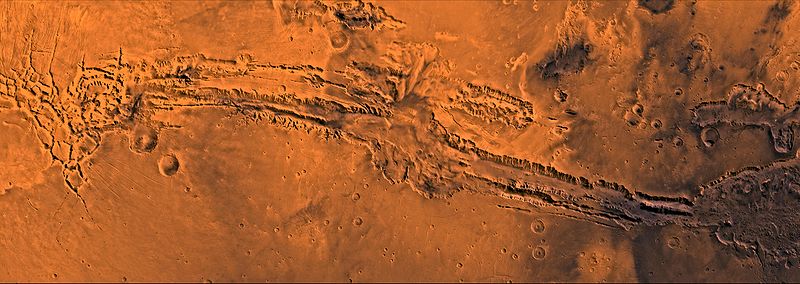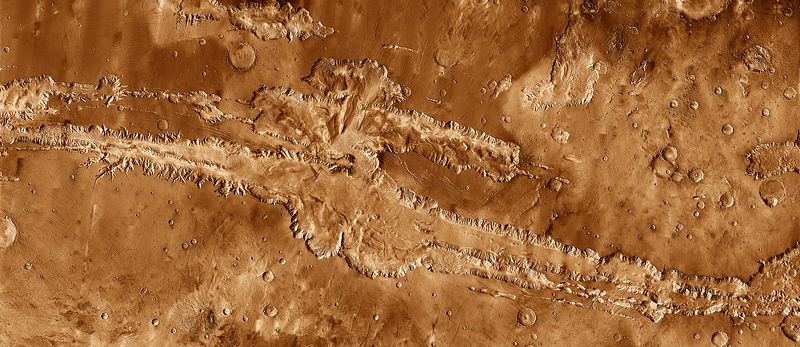Mars
~ Plate Tectonics on Mars?
 PIA00422: Valles
Marineris Courtesy NASA /
JPL-Caltech / USGS (Click Image for full size)
PIA00422: Valles
Marineris Courtesy NASA /
JPL-Caltech / USGS (Click Image for full size)
Valles
Marineris is a vast canyon system that runs
along the Martian equator. At 4,500 km long, 200
km wide and 11 km deep, the Valles Marineris
rift system is ten times longer, seven times
wider and seven times deeper than the Grand
Canyon of Arizona, making it the largest known
crevice in the solar system.
PRESS RELEASE: 99-56
MAGNETIC STRIPES PRESERVE RECORD OF ANCIENT MARS
NASA's Mars Global Surveyor has discovered
surprising evidence of past movement of the Martian
crust, further evidence that ancient Mars was a more
dynamic, Earth-like planet than it is today.
Scientists using the spacecraft's magnetometer have
discovered banded patterns of magnetic fields on the
Martian surface. The adjacent magnetic bands point
in opposite directions, giving these invisible
stripes a striking similarity to patterns seen in
the crust of Earth's sea floors. On the Earth, the
sea floor spreads apart slowly at mid-oceanic ridges
as new crust flows up from Earth's hot
interior. Meanwhile, the direction of Earth's
magnetic field reverses occasionally, resulting in
alternating stripes in the new crust that carry a
fossil record of the past hundreds of million years
of Earth's magnetic history, a finding that
validated the once-controversial theory of plate
tectonics.
"The discovery of this pattern on Mars could
revolutionize current thinking of the red planet's
evolution," said Dr. Jack Connerney of NASA's
Goddard Space Flight Center, Greenbelt, MD, an
investigator on the Global Surveyor's magnetometer
team. "If the bands on Mars are an imprint of
crustal spreading, they are a relic of an early era
of plate tectonics on Mars. However, unlike on
Earth, the implied plate tectonic activity on Mars
is most likely extinct."
Alternate explanations for the banded structure may
involve the fracturing and breakup of an ancient,
uniformly magnetized
crust due to volcanic activity or tectonic stresses
from the rise and fall of neighboring terrain.
"Imagine a thin coat of dried paint on a balloon,
where the paint is the crust of Mars," explained Dr.
Mario Acuna of Goddard, principal investigator on
the Global Surveyor magnetometer. "If we
inflate the balloon further, cracks can develop in
the paint, and the edges of the cracks will
automatically have opposite polarities, because
nature does not allow there to be a positive pole
without a negative counterpart."

NASA
/ JPL-Caltech / Arizona State University (Click Image for full
size)
A
ragged geological scar crosses the belly of
Mars. Long enough to reach from New York
City to Los Angeles, this great rift in the
martian crust is named Valles Marineris, or
Mariner Valley. It was discovered in 1972 by
the Mariner 9 spacecraft. Formed out of
several parallel, connecting troughs, Valles
Marineris dwarfs Earth's Grand Canyon in
every respect, being wider, longer, deeper,
and older. It easily earns the title of
Grandest Canyon of All.
This mosaic image of Valles
Marineris - colored to resemble the martian
surface - comes from the Thermal Emission
Imaging System (THEMIS), a visible-light and
infrared-sensing camera on NASA's Mars
Odyssey orbiter. Mars Odyssey was built by
Lockheed Martin and the mission is operated
by the Jet Propulsion Laboratory.
Built from more than 500 daytime
infrared photos, the mosaic shows the whole
valley in more detail than any previous
composite photo. Despite the valley's huge
extent - including its western extension
through Noctis Labyrinthus, it reaches some
3,000 kilometers (2,000 miles) long - the
smallest details visible in the image are
about the size of a football field: 100
meters (328 feet).
This is a reduced size
(approximately one fourth the linear pixel
density) and cropped (at the bottom) version
of the original 23,711 x 11,856 pixel THEMIS
mosaic, and has also been adjusted in hue
and saturation.
Peer-reviewed research based on the observations
will be published in the April 30 issue of the
journal Science.
The observations of the so-called magnetic stripes
were made possible because of Mars Global Surveyor's
special aerobraking
orbit. This process of dipping into the upper
atmosphere of Mars to gradually shape the probe's
orbit into a circle was extended due to a problem
with a solar panel on the spacecraft. The
lowest point of each elliptically shaped orbit
curved below the planet's ionosphere, allowing the
magnetometer to obtain better-than-planned regional
measurements of Mars.
"At its nominal orbit more than 200 miles high, the
instruments face too much magnetic interference, and
they do not have the resolution to detect these
features," Acuna noted. "We began with
misfortune, and ended up winning the lottery."
The bands of magnetized crust apparently formed in
the distant past when Mars had an active dynamo, or
hot core of molten
metal, which generated a global magnetic
field. Mars was geologically active, with
molten rock rising from below cooling at
the surface and forming new crust. As the new
crust solidified, the magnetic field that permeated
the rock was "frozen" in the
crust. Periodically, conditions in the dynamo
changed and the global magnetic field reversed
direction. The oppositely directed magnetic
field was then frozen into newer crust.
"Like a Martian tape recorder, the crust has
preserved a fossil record of the magnetic field
directions that prevailed at different times in the
ancient past," Connerney said. When the
planet's hot core cooled, the dynamo ceased and the
global magnetic field of Mars vanished.
However, a record of the magnetic field was
preserved in the crust and detected by the Global
Surveyor instrument.
The mission's map of Martian magnetic regions may
help solve another mystery -- the origin of a
striking difference in
appearance between the smooth, sparsely cratered
northern lowlands of Mars and the heavily cratered
southern highlands. The map reveals that the
northern regions are largely free of magnetism,
indicating the northern crust formed after the
dynamo died.
"The dynamo likely died a few hundred million years
after Mars' formation. One possibility is that
later asteroid impacts followed by volcanic activity
heated and shocked large areas of the northern
crust, obliterating any local magnetic fields and
smoothing the terrain," Acuna said.
"When the crust cooled, there was no longer a
global magnetic field to become frozen in
again."
The map also identifies an area in the southern
highlands as the oldest surviving unmodified crust
on Mars. This area on Mars
is where the magnetic stripes are most prominent.
The bands are oriented approximately east-to-west
and are about 100 miles wide and 600 miles long,
although the longest band stretches more than 1,200
miles.
"The bands are wider than those on Earth, perhaps
for a couple of reasons," Connerney said. "The
Martian crust could have
been generated at a greater rate, causing a given
magnetic field to be imprinted over a wider area
before it reversed direction. Second, the Martian
magnetic field may have reversed direction less
frequently, which would have given more time for any
one field direction to imprint itself in the
steadily moving crust, resulting in wider bands.
"In order to call this pattern a crustal spreading
center like that observed in the mid-oceanic ridges
on Earth, we need to
find a point of symmetry, where the pattern on one
side matches the pattern on the other. We have not
yet found evidence of this type of symmetry,"
Connerney added.
Graphics of the magnetometer data, other supporting
material and general information on the Global
Surveyor mission may be found on the Internet at:
- FTP://PAO.GSFC.NASA.GOV/newsmedia/MARS/MAGNETIC/
- http://mpfwww.jpl.nasa.gov/mgs/index.html
- end -
|


